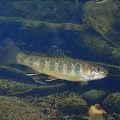Fish Science: “The Fatty Little Fin”
Smelt, some dragonfish, and even some trout-perch possess it. So do species belonging to the lanternfish and the catfish families. The much-maligned piranha has one. As does the more glamorous golden dorado. And all the salmonids have one, it’s diagnostic for their group.

Golden dorado – Salminus brasiliensis. Image: Wikimedia commons.
What all these fish have in common is an adipose fin, that “mysterious little fatty fin” as it has been described. Fly fishers seeking our traditional quarry often come face to face with the fin, yet it is in fact a rare attachment existing in only eight orders (a term for a collection of similar species) and absent in all other major and more recent groups. The Cypriniformes, the club containing carp and a multitude of other familiar species, do not have one. Nor, surprisingly, do the Perciformes, the largest order of fish and the largest family of vertebrates in the world. That second fin you see on your bass and bluegills, perch and pumpkinseeds is just an additional dorsal. Not a separate entity at all.
For those groups that do have an adipose its presence can be rather patchy. In the Siluriformes for example, an order containing in the region of 2,500 different kinds of catfish, some species display the fin and some do not. It’s not until we come to the Salmoniformes that the fin reaches its apogee being present in all three lineages, the whitefish (Coregoninae), grayling (Thymallinae) and of course salmon and trout (Salmoninae).
The fin’s presence in a few species, particularly those that are traditional targets of fly fishermen, but its absence from the vast majority of other fish, might reasonably prompt the question – why is the adipose there at all? Not only is it missing from most fish but it is also small, seems to have no rays or muscular attachments and cannot be wiggled for any purpose in the current. Yet the fin persists and so one wonders whether we’ve missed something, some subtle function. Perhaps it aids balance, helps propel or maneuver a fish in some way. Maybe it is a flow sensor, a widget of fitness, or even a lure for the opposite sex. Or is it really functionless; is it in fact, a classic example of a vestigial organ like the hind limbs of whales or the ‘feet’ of some snakes? A vestigial status is a common assumption and as a consequence fisheries biologists assume that snipping off the fin incurs no cost, no long term harm to the amputee. But, vestigiality is a complicated topic and classifying any organ as a relic has to be done with some caution, even for our once useful bits.

Lake Whitefish – Coregonus clupeaformis. Image: Wikimedia commons.
In 1893 the anatomist Robert Wiedersheim suggested there were 86 vestigial organs in humans. Back then, with no scientific tools allowing the detailed examination of each organ’s function, his list may have seemed reasonable. Now the vestigial status of many of those organs has been re-evaluated. The vermiform appendix, the classic human vestigial organ, is not immune to this revision. Recent work has suggested that it is a left-over from ancestors who ate more vegetable matter than we do now and in one study the authors suggest that far from being without a role the appendix may provide a useful service. Following a bad bout of the runs, when diarrhea caused by cholera or some other debilitating or deadly disease flushes out the bacteria flourishing in the intestinal tract, a remaining population residing in the safe haven of the appendix could recolonize the gut and get back to the good work of digestion. Removing the organ from a healthy person living in a country with adequate diet and medical care may make no discernible difference. By contrast, excising the appendage from a person living in dire poverty, existing on little and low quality food and without access to even vaguely reasonable medical care, might cause some difficulty. Might, the idea is not proven and there is a deal of debate as to the accuracy of these claims as there few clear cases available to show a detrimental effect of appendix removal. Yet it demonstrates, as do many other examples, that once defined vestigial organs might not be quite so unemployed.
Which leads us back to this mysterious fatty fin. If many vestigial organs once thought to have no function, thought to be degenerating examples of what once was useful, are now considered to be necessities would this apply to the adipose too? Biologists have been interested in this for some time. It has been noted that the fin is not fixed in its form – there is a temporal pattern of growth and enlargement associated with reproduction. Only in the males though, no equality of the sexes in this development. The adipose of males increases along with other secondary sexual characteristics (jaw length and the development of the kype, body depth and skin color being a few) at spawning time. Females persist with their demure fins representing, when contrasted to the male’s, a clear case of sexual dimorphism—not quite as elaborate as a peacock’s tail but you get the picture. Describing changes in form is a small part of the story. What function does this growth imply?

Sockeye salmon – Oncorhynchus nerka. Image: Wikimedia commons.
A number of studies suggest that female salmon and brown trout show a preference for males with large adipose fins. They show a preference for other traits as well, body size and a general ability to establish and defend territories. But when all the individual attributes of competing males are separated into their component parts, the size of the adipose is still a significant factor when females choose a male to fertilize their eggs. What is more there appears to be some advantage to the offspring sired by these males as they are more active and may be better at defending their own territories. This is all relatively straightforward if it wasn’t for those pesky males messing everything up. It is true that when females are left unmolested, left to view some males and choose which one to excavate a nest next to, the size of the adipose is a significant factor. However in the hurly-burly of the redds females seldom seem to get that chance. Males form dominance hierarchies and the largest and most aggressive tend to monopolize females.
More recently a study on the garish arctic charr leant another feature to the fin’s role. Males inflate their adipose in only a few days and along with other changes (that kype and skin color again) use these as indicators of the owners’ fitness. The males compete hard for spawning territories and establish hierarchies between themselves. Those that become dominant keep their larger adipose for the duration of spawning, whereas the adipose of the losers, deflates. Interestingly, the adipose is thought to convey a particular piece of information. To enlarge the fin takes energy and those fish that can grow a nice big one and maintain it are showing that they’ve stored so many extra resources that they can divert some from general maintenance and other energy hungry processes to grow and maintain this ‘trivial’ little fin. It signals to watching females that the male is good at getting food and so his offspring are also likely to be good foragers (the kype n the other hand is suggested to signal how healthy the fish is, how good an immune response it can mount against parasites). So, as it is expensive to grow and maintain, fish that find themselves out-competed on the prime spawning grounds stop sending their excess resources to the adipose. Why bother wasting the energy on the fin if all the females have their heads turned by those overblown males holding good gravel territories?

Columbia River redband trout – Oncorhynchus mykiss gairdnerii. Image: Wikimedia commons.
The fin’s role in swimming has also become clearer in recent years. One research group had a look at whether fin clipped juvenile steelhead were at a disadvantage when swimming. The biologists measured tail beat frequency and amplitude at different flow speeds and having established what the steelhead did with their adipose intact the researchers then snipped off the fin and put the fish through their paces again. In all but the smallest fish tail beat amplitude increased by about 8%, not a lot but a significant change to the beat amplitude recorded prior to adipose removal. The fin then has a role to play in increasing the efficiency of sustained swimming. The researchers also thought they saw some small nerves running to the base of the fin and in a subsequent study demonstrated that these nerves were indeed present – the first time this had categorically been shown. Their presence strongly supports their initial idea that the fin is a ‘precaudal flow sensor’ especially useful when the fish has to maneuver in turbulent water. Fish with their adipose fin removed are likely to have higher energy expenditure than those retaining the fin, a costly loss in a dynamic aquatic environment.
The adipose fin then would not seem to be a classic case of a vestigial organ. Indeed, most biologists now consider it has had the opposite history. Rather than shrinking from declining use the adipose appears to have been a fin that started growing and then stopped as if having poked its head out into the big bad world it didn’t like what it saw and refused to go any further. What is more, and an underlying irony, the fin is not fatty. It contains no adipose tissue. A fleshy fin that is an important signal of male fitness and a flow sensor providing feedback in turbulent water prompts a final obvious question. Why fin clip?
Many fisheries routinely use the adipose fin clip to mark hatchery fish. It’s a cheap, reproducible and robust way of subsequently identifying definned fish at a later date. And since hatchery fish reared on federal funding (and there is a plague of them—Washington State mark 100 million salmon for release each year) have to be tagged (’tis the law), economy is the watch word. Recognizing that fin amputation, clipping or marking in any way might affect fish survival a number of studies have looked for an effect of fin loss on a fish’s susceptibility to predation, its growth or stamina. Most haven’t shown any consequence of adipose removal. Nor does the most recent, a study on return rates of sea run brown trout going from the hatchery on the Dalälven river in Sweden, out to the Baltic and back again some 20 months later. Trouble is many of these studies were conducted in still water where the cost of removal are unlikely to show. The Swedish study released fish into a broad, far from turbulent river and re-sampled them back at the research station only six miles from the sea.
All in all it is tempting to question the removal of the adipose. It may well be costly to the fish and might further separate hatchery fish from the wild originals they are meant to imitate, a process already well documented to have occurred in the rearing pens. A hatchery smolt sent seawards would not encounter the costs of fin removal in the ocean but might on its return to the river. The decreased efficiency of their upstream struggle therefore could cost a finless fish more energy while leaving it less, in the males case at least, to fight and attract a female. But, as many of the rivers of their return are characterized by dams and decreased flows, the very lack of turbulent water a fish with an adipose may have an advantage in, the costs may not be realized even here. We end up with mutilated fish in an emasculated river, perhaps an apt description for the recent history of anadromous salmonids.











